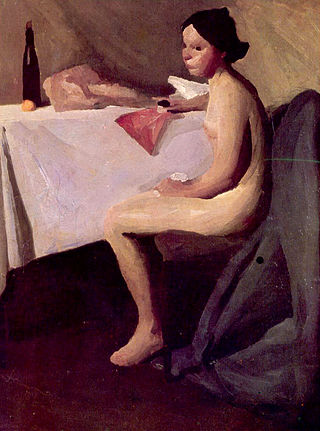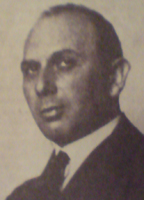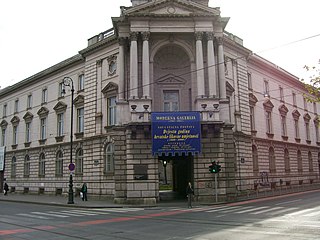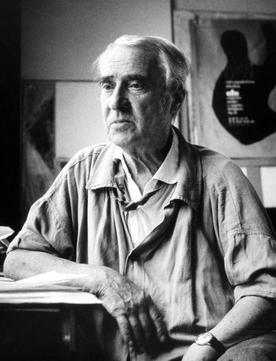
Naïve art is usually defined as visual art that is created by a person who lacks the formal education and training that a professional artist undergoes. When this aesthetic is emulated by a trained artist, the result is sometimes called primitivism, pseudo-naïve art, or faux naïve art.

Ivan Generalić was a Croatian painter in the naïve tradition.

Edo Murtić was a painter from Croatia, best known for his lyrical abstraction and abstract expressionism style. He worked in a variety of media, including oil painting, gouache, graphic design, ceramics, mosaics, murals and theatrical set design. Murtić travelled and exhibited extensively in Europe and North America, gaining international recognition for his work, which can be found in museums, galleries and private collections worldwide. He was one of the founders of the group "March" (Mart) in 1956, and received many international awards. In 1958 Murtić participated in the three biggest events in the world of contemporary art: the Venice Biennale, the Carnegie Prize in Pittsburgh, and Documenta in Kassel. Interest in the art of Edo Murtić continues to grow, with retrospective exhibits in major museums.
Ivan Lacković Croata was a Croatian naive painter.

Franjo Mraz was a notable Croatian artist. Together with Ivan Generalić and Mirko Virius, he is considered a founder of Croatian naive art. His most famous paintings are "Oranje" ('Ploughing') and "Zima" ('Winter').
Hlebine is a municipality in Koprivnica-Križevci County in Croatia. It consists of two villages, Hlebine and Gabajeva Greda.

Croatian art of the 20th century, that is visual arts within the boundaries of today's Croatia, can be divided into modern art up to the Second World War, and contemporary art afterwards.

Krsto Hegedušić was a Croatian painter, illustrator and theater designer. His most famous paintings depict the harsh life of the Croatian peasantry in the manner of naive art. He was one of the founders of the Earth Group.

Vladimir Becić (1886–1954) was a Croatian painter, best known for his early work in Munich, which had a strong influence on the direction of modern art in Croatia.

Oskar Herman (1886–1974) was a Croatian-Jewish painter. He was one of the group of Croatian artists known as the Munich Circle, who had a strong influence on modern art in Croatia.

Modern Gallery is a museum in Zagreb, Croatia that holds the most important and comprehensive collection of paintings, sculptures and drawings by 19th and 20th century Croatian artists. The collection numbers around 10,000 works of art, housed since 1934 in the historic Vranyczany Palace in the centre of Zagreb, overlooking the Zrinjevac Park. A secondary gallery is the Josip Račić Studio at Margaretska 3.

Menci Clement Crnčić was a Croatian painter, printmaker, teacher and museum director. He studied painting and drawing in Vienna and Munich, and trained in graphic arts in Vienna, studying etching and engraving. He was the first artist in the Croatian graphic tradition to abandon a strictly linear style and use tonal variation to create contrasting areas of light and shade.

The Croatian Museum of Naïve Art is a fine art museum in Zagreb, Croatia dedicated to the work of naïve artists of the 20th century. The museum holdings consist of over 1,900 works of art - paintings, sculptures, drawings and prints, mainly by Croatians but also by other well-known international artists in the genre.
Matija Skurjeni (1898–1990) was a Croatian painter associated with the naïve art movement. He helped to found the Association of Independent Naïve Artists of Croatia and he is considered one of the most influential independent naïve artists. He has five rooms of his work at the Croatian Museum of Naïve Art and many of his works at the Matija Skurjeni Gallery in Zaprešić.

Mijo Kovačić is a Croatian painter and naïve artist. His works can be found at the Croatian Museum of Naïve Art in Zagreb.
Martin Mehkek was a Croatian painter. His works can be found at the Croatian Museum of Naïve Art in Zagreb. He is one of the most important members of the second generation of the "Hlebine School of Painting" and his works can be found in numerous private and public collections, galleries and museums. His typical motifs are mainly portraits of Roma, workers and farmers as well as scenes from everyday patriarchal life and the difficult life in the Podravina villages.

Marino Tartaglia was a Croatian painter and art teacher, for many years a professor at the Academy of Fine Arts, Zagreb.
Edo Kovačević was a Croatian artist, best known for his colourful landscapes and views of suburban Zagreb. He worked mainly in oils and pastels, using subtle colour harmonies and lively brush strokes to bring out the natural beauty of ordinary subjects. Kovačević also designed theatrical stage sets for the Croatian National Theatre, the Drama Theatre and the Puppet Theatre, for many years, taught art at the Zagreb School of Crafts, and organized art exhibitions and installations.

The art of Yugoslavia is the visual art created by a number of painters, sculptors and graphics artists in Yugoslavia.
Slavko Kopač was a French painter, sculptor and poet.













